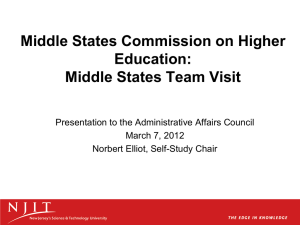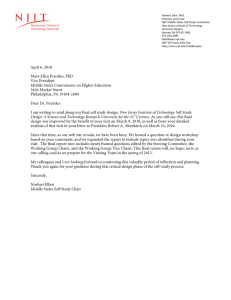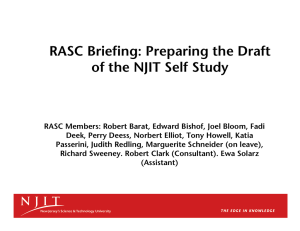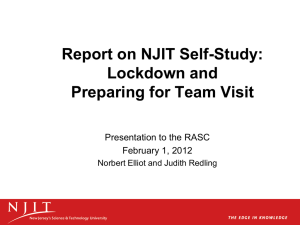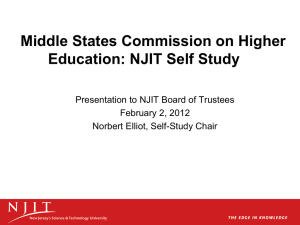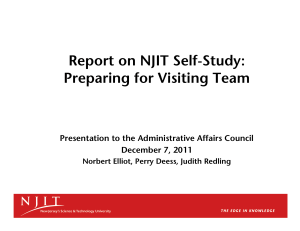Post-Liaison Review Workshop: Spring 2010 MSCHE Self Study Plans
advertisement
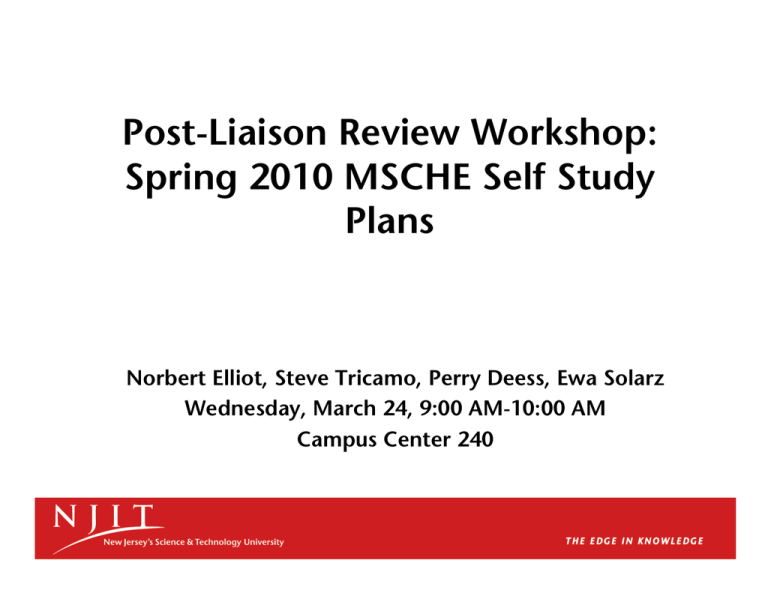
Post-Liaison Review Workshop: Spring 2010 MSCHE Self Study Plans Norbert Elliot, Steve Tricamo, Perry Deess, Ewa Solarz Wednesday, March 24, 9:00 AM-10:00 AM Campus Center 240 Transition: From Design to Reporting Visit from Mary Ellen Petrisko, March 9, 2010 • • • • • • Group 1: Standard 1: Mission and Goals —“target mission differentiation, global initiatives, processes surrounding strategic planning.” Research Questions: 1.1: Alignment with Strategic Plan 2004-2010; 1.10: Relationship between SS and 2010-2015 strategic plan: Do you have greater clarity on this? 1.2.2. Not clear to me: does everyone in the workgroup have shared understanding? Will this be clear to team chair? 1.1., 1.2.1., 1.6: If answer is yes, or no, what then? 1.3, 1.4, 1.5, 1.7: Could be answered purely descriptively. Are there questions behind these questions? How is “how” understood— to be descriptive of current practice or trying to figure out what practice should be? (This is a question to be considered throughout the design.) • • • Group 2: Standards 2 and 3: Planning, Resource Allocation, Institutional Renewal —“Here, we focus on the NJIT resource allocation process” What about strategic planning and the overlap between groups 1 and 2? Narrative here seems to emphasize Standard 3. Also, discussion of figure 7 talks about relationship across 1,2, 3 but does not specifically talk about mission/goals/ planning. Need greater clarity on new strategic plan and how this process aligns with it. Research Questions: 2.0, 2.1, 2.2, 2.3, 2.4, 2.5, etc. might be answerable descriptively. Are there questions behind these questions? Visit from Mary Ellen Petrisko, March 9, 2010 • • • • • Group 3: Standards 4, 5, 6: Leadership and Governance, Administration, Integrity Research Questions: 3.1.3, If answer is yes, or no, what then? 3.0, 3.2, 3.3, 3.4, 3.5, 3.6, 3.7, 3.8, etc. might be answered descriptively. Are there questions behind these questions? 3.1, 3.10, 3.15 Not sure I understand: does everyone in the workgroup have shared understanding? Will this be clear to team chair? • • • • Group 4: Standards 7 and 14: Institutional Assessment and Student Learning Assessment —“there remains a need to formulate a cohesive, university-wide assessment plan” How will this be tied into development of strategic plan? Note that title of group on p 19 is “Educational Outcomes: The Measurement of Learning Ability”—be sure there is also emphasis on institutional effectiveness. Research Questions: 4.1, 4.6, 4.8, 4.9, 4.10, 4.12, 4.13: If the answer is yes, or no, what then? 4.2, 4.4, 4.5, 4.7, 4.14 might be answered descriptively. Are there questions behind these questions? Visit from Mary Ellen Petrisko, March 9, 2010 • • • • • • Group 5: Standards 8 and 9: Student Admissions and Retention and Student Support Services—“graduation rates remain a challenge to NJIT” No students on this working group? Research Questions: 5.2: Not sure what this means: does everyone in the workgroup have shared understanding? Will this be clear to team chair? 5.4, 5.5, 5.6, 5.7, 5.10, 5.12, 5.13, etc. might be answered descriptively. Are there questions behind these questions? 5.11: If the answer is yes, or no, what then? 5.24: Are you sure that improving curriculum delivery is a factor in retention? • • • Group 6: Standard 10: Faculty—“tensions between research and instruction” Research Questions: 6.0, 6.1, 6.2, 6.3, 6.5, 6.6, 6.7, etc. might be answered descriptively. Are there questions behind these questions? Visit from Mary Ellen Petrisko, March 9, 2010 • • • • Group 7: Standards 11, 12, 13: Educational Offerings, General Education, Related Educational Activities Research Questions: 7.2, 7.4, 7.6, 7.11, 7.12, 7.15, 7.16, etc. might be answered descriptively. Are there questions behind these questions? 7.7 : If the answer is yes, or no, what then? • • Timeline: According to design, you will be studying the university “to the fall of 2011”. What will cut-off date be for data that will be included? The team chair is to review the draft during the fall and visits at least four months prior to the visit, so draft needs to be done in time for a community review and review by the team chair during this semester. Be sure to allow yourself sufficient time. (See also milestones on p. 48: looks like much is happening at the same time; may be good to be more specific with dates.) Organization of the SS: proposed outline: Be sure to allow for discoveries in your research Agenda • • • • New Timeline Spring 2010 Activities Finalize Question Design Discussion New Timeline (Excerpt of Tasks from 2010 Middle States Self Study Design) TASK START Submission of self-study design to Liasion END DURATION NOTES April 6, 2010 Working Groups Gather Data/Reports April 1, 2010 April 30, 2011 Working Groups Draft and Submit Report to RASC January 1, 2011 April 30, 2011 1 year 1 month Working Groups receive requests for revisions April 30, 2011 May 31, 2011 1 month Working Groups submit final report June 1, 2011 July 1, 2011 1 month RASC Drafts Self Study Report July 1, 2011 August 31, 2011 2 months Campus community reviews draft September 1, 2011 September 30, 2011 1 month NJIT Governing Board reviews draft October 1, 2011 October 31, 2011 1 month Draft is final November 1, 2011 Team chair receives finalized draft November X, 2011 2 weeks before visit Team Chair visits December X, 2011 4 months prior to visit Self-study report finalized and sent to evaluation team February X, 2012 6 weeks prior to visit Evaluaiton team visit to NJIT April X, 2012 usually conducted before mid-April New Timeline Spring 2010 Activities • Two meetings • Recorded in NJIT MSCHE Self Study Format • Meeting 1: Document and Study Identification • Meeting 2: Document and Study Verification Example: Document Identification Example: Study Identification Final Question Design Strategies: MSCHE Advice • Ask – Questions that stimulate thinking about important topics – Questions that allow the self-study to address the standards through the lens of specific institutional traits, developments, or issues – Questions that require evaluation and judgment – Questions that are worth the effort it will take to answer them – Questions that connect standards and different dimensions of the institution (31) Final Question Design Strategies: An NJIT Rhetorical Design Taxonomy • • • • • • Necessary but not sufficient Descriptive: To unpack Expository: To explain Classificatory: To group Analytic: To explain referentially Argumentative: To prove Provocative: To suggest Good but check resource allocation Model: Descriptive • “How are the major themes of the mission reflected in the institution’s goals? If the mission calls for students to acquire an appreciation of certain values, for example, what activities exist to achieve this?” (33) Model: Expository • “To what extent is the conceptual and procedural relationship between the institution’s strategic plan and the budget development process (both operational and capital) well understood and effectively implemented?” (34) Model: Classificatory • “What are the most significant challenges facing the institution relative to human resources, technology resources, and physical plant resources over the next five years?” (35). Model: Analytic • “How does the institution know that its policies and practices actually enable it to recruit, develop and retain faculty who support the teacher/scholar model? How does its success in doing that compare to peer institutions?” (37) Model: Argumentative • “In what ways and for what reasons have staffing patterns and reporting lines been changed within the past five years? How appropriate were those changes?” (36) Model: Provocative • “If graduates are not meeting expected competency levels, how does the institution address this? To what extent and in what particular ways has the institution used assessment results to modify the educational program and services? Have such modifications brought demonstrable improvement? What should be done in the future?” (38-39) Key Phrases for Final NJIT Question Design • 1.3 What are the causal factors—external and internal forces that impact the university—for change? How can we determine the strength and influence of these forces? • 3.4 What evidence can be provided that effective strategies are in place to assure the leadership future of NJIT in the areas of education, research, economic development, and service? • 6.6 How might mentoring plans be enhanced and communicated to assist new faculty in developing and refining their skills to achieve excellence in instruction, research, and service? • 7. 6 How effective are the processes that allow new degree programs to emerge at NJIT? Are the standards and processes are required for program approval on the institutional and state level sufficient to allow NJIT’s needed mission differentiation? Three Possible Revisions • Accept as is • Modify with minor revision • Modify with intention – – – – Classificatory: To group Analytic: To explain referentially Argumentative: To prove Provocative: To suggest
